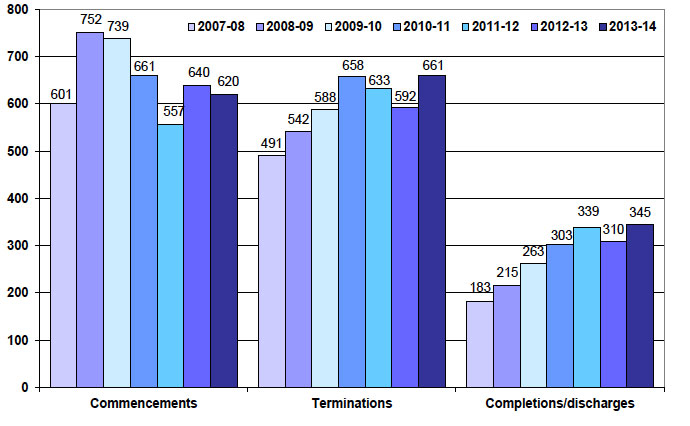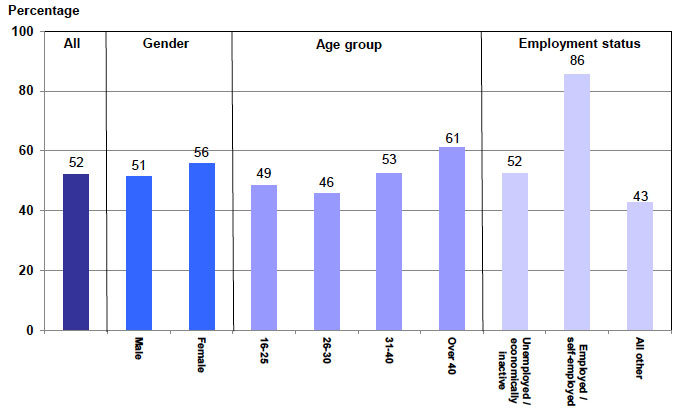Criminal justice social work statistics in Scotland: 2013-14
An annual publication of statistics on community payback and other social work orders, including breaches and terminations of orders, as well as criminal justice social work (CJSW) reports and other areas of CJSW.
This document is part of a collection
5.4 Drug treatment and testing orders
5.4.1 The drug treatment and testing order is available to courts (excluding justice of the peace courts) as a high tariff disposal for offenders with substance use problems who might otherwise get a custodial sentence. In addition, the less intensive DTTO II has been available to all courts in City of Edinburgh, East Lothian and Midlothian on a pilot basis since 2008, and currently accounts for about a quarter of the DTTOs in these areas (see §B.5). Data for 2012-13 onward are collected at unit level, while earlier figures are based on aggregate data and so caution is suggested when comparing the two sets of figures (see Annex A for more details).
5.4.2 A total of 620 drug treatment and testing orders commenced in 2013-14 (including the DTTO II). This represents a decrease of 3 per cent on 2012-13, and is 18 per cent lower than the peak of 750 in 2008-09 (Table 1 and Chart 8). Male offenders accounted for 80 per cent of DTTOs commenced in 2013-14 (Table 23). The incidence of DTTOs was highest amongst 26 to 40 year olds (around 4 per 10,000 population), and was lowest (around ½ per 10,000 population) for under 21s and over 40s.
5.4.3 Eighty-six per cent of people getting a DTTO were either unemployed or economically inactive.
Chart 8 Drug treatment and testing order commencements, terminations and completions/discharges: 2007-08 to 2013-14

5.4.4 The average length of a DTTO in 2013-14 was 17.4 months, slightly shorter than in 2012-13. Average lengths have consistently sat at around 18 months over the last five years (Table 23).
5.4.5 Seventy-six per cent of DTTOs commenced in 2013-14 had first direct contact within one working day of the order being imposed, only slightly lower than in 2012-13 (78 per cent). Only 9 per cent of cases in 2013-14 took longer than five working days (Table 24).
5.4.6 There was a substantial improvement in the proportion of first case management meeting taking place within five working days - 86 per cent in 2013-14 compared with 74 per cent in 2012-13. In 2013-14, only 9 per cent of cases took longer than ten working days.
5.4.7 The reasons provided for not complying with these timescales in 2013-14 suggest that this offender group presents more challenges, as not attending meetings without an excuse is more prevalent than for other offender groups - 54 per cent for the initial contact meeting and 53 per cent for the induction/ case management meeting (Table 25).
5.4.8 There were 710 drug treatment and testing orders in force on 31 March 2014 (Table 1).
5.4.9 In 2013-14, the number of DTTO terminations rose to 660, the highest level in any of the last seven years (Tables 1 and 26). Fifty-two per cent of terminations were completions/discharges in 2013-14; this is similar to the previous two years and higher than the proportions of around 40 to 45 per cent observed prior to 2010-11 and before. The completion rate for DTTOs does tend to be lower than for other social work orders, due to the type of offender involved.
5.4.10 Twenty per cent of orders were revoked due to review, with 23 per cent revoked due to breach (Table 26). The remaining 5 per cent were terminated for other reasons (including transfer out of the area or death). A custodial sentence was imposed in 51 per cent of revoked cases (Table 27).
5.4.11 Seventy-two per cent of orders were terminated without breach applications (Table 28). The vast majority (86 per cent) of the breach applications were lodged with the court within 5 working days of the decision being made to make an application (see the additional datasets which accompany this publication).
5.4.12 Completion rates varied markedly by age and employment status (Chart 9), with older offenders and those in employment being more likely to complete. Over 60 per cent of people aged over 40 successfully completed compared with 46 per cent of those aged 26 to 30. Over 80 per cent of those who were employed / self-employed completed their order, compared to just over half for those who were unemployed or economically inactive.
Chart 9 Completions/discharges of drug treatment and testing orders by gender, age and employment status: 2013-14

Notes: Age and employment status at termination. Figures may include a small number of under 16s.
Contact
Email: Alan Fleming
There is a problem
Thanks for your feedback